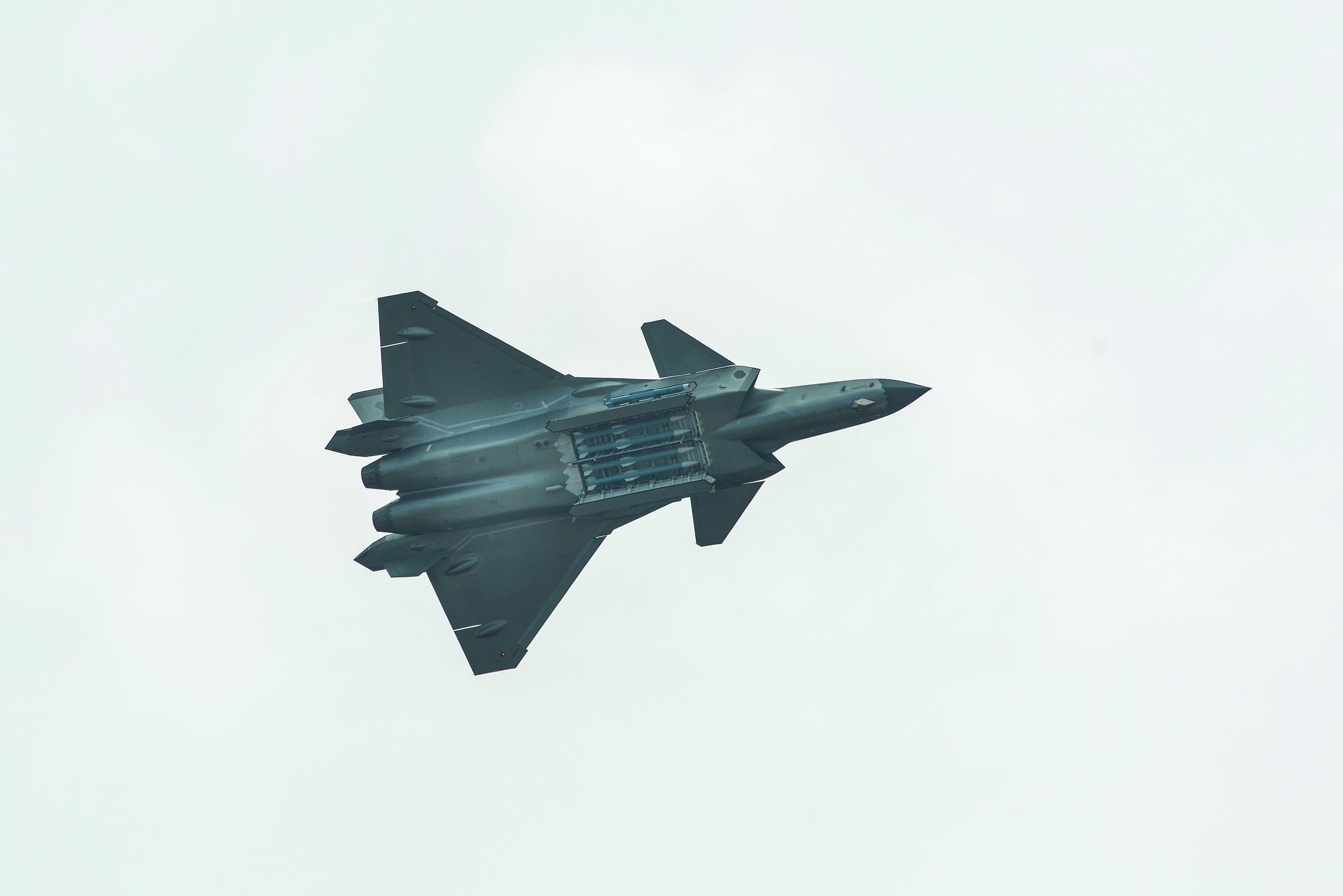
"The adversary gets a vote,” is a much-touted phrase in the halls of the Pentagon. Unfortunately, not everyone in the U.S. military is responding quickly enough to China’s vote: the development and fielding of its Chengdu J-20 fifth-generation fighter.
The U.S. Air Force has launched a series of projects to produce revolutionary air combat capabilities, but those programs will not bear fruit until the latter half of the decade or beyond. Any changes in the next five years may be tied to altering procurement of existing platforms. But Adm. Philip Davidson, Indo-Pacific Command chief, says the time to transform is now. “Our adversaries are developing or are fielding already fifth-gen fighters themselves,” he says. “To go backward into fourth-generation capability as a substitute, broadly, would be a mistake in my view and would actually put us at a severe disadvantage over the course of this decade.”
- U.S. is not adequately addressing threat posed by Chinese airpower
- J-20’s stealth and sensors are an advantage against fourth-gen fighters
- Until 2030, the majority of USAF fighters will be fourth-gen
- For a complete history and technical breakdown of the J-20 program, AWIN members can access the full program profile here.
For years, the Air Force touted the advantage that its fifth-generation Lockheed Martin F-22 Raptor and F-35 Lightning II would hold over their fourth-generation adversaries. The notion that the service’s fourth-generation Lockheed F-16s and Boeing F-15s soon will be confronted by significant numbers of advanced Chinese aircraft has not sunk in. Yet the emerging arena of fifth-generation versus fifth-generation fighter combat still looms on the horizon.
Since the release of the 2018 U.S. National Defense Strategy, China’s People’s Liberation Army Air Force (PLAAF) has equipped three units with production configuration J-20As. This group includes the 9th Brigade at Wuhu, the 172nd Brigade at Changzhou and the 1st Brigade at Anshan. The J-20s at Anshan are powered by domestic WS-10 engines. Despite its smaller J-20A fleet, the 172nd holds particular importance as it develops new techniques, tactics and procedures for the type in concert with the 176th Brigade at Dingxin. The total J-20 fleet numbers at least 40 airframes of all types and by 2027 could equal the U.S. Air Force’s fleet of 185 F-22s.
Western sources describe the J-20 as a low-observable (LO) interceptor operating within an anti-access/aerial denial (A2/AD) framework, optimized to target tankers and command, control, computers, communications, intelligence, surveillance and reconnaissance (C4ISR) aircraft—thereby eroding U.S. power projection capabilities. Domestic sources, however, universally describe the aircraft as China’s premier air-superiority fighter meant to engage other fighters.
In a 2017 interview, PLAAF Brigade Commander Xiao Jun agreed that the J-20’s purpose was to sweep away all fourth-generation fighters, though he added that the true strength of the aircraft was part of a broader systems of systems approach. A September 2020 article published in the Global Times, a Chinese Communist Party outlet, reported kill ratios of 17:0 by the 9th Air Brigade in exercises between the J-20 and other fighters. PLAAF pilot Chen Xinhao, who reportedly had only 100 flight hours in the aircraft, remained undefeated throughout the event. Newly minted Air Force F-35 pilots have claimed similar kill ratios about the Lightning II while participating in Red Flag exercises. Even though all performance claims in exercises are generally subject to scrutiny regarding the rules of engagement, scenarios and so forth, J-20s are continually pitted against other fighters, affirming the aircraft’s role in air dominance. Andreas Rupprecht, author of Modern Chinese Warplanes, notes in a recent interview with Hush-Kit digital magazine that the F-22 was the benchmark against which Chengdu evaluated the J-20’s performance.
Moreover, the J-20’s design features—the extensive flight-control surfaces on its wing, its bubble canopy, the use of foreplanes for angle-of-attack control, among others—point toward a platform expected to operate in air-superiority missions or even within-visual-range engagements. Chief test pilot Li Gang described the J-20 as having comparable maneuverability to the F-16-class Chengdu J-10 while having significantly better LO performance. The J-20 could act as an interceptor against high-value targets, just not exclusively so.
Clearly, Chengdu’s engineers understand the foundation of fifth-generation design: the ability to attain situational awareness through advanced fused sensors while denying situational awareness to the adversary through stealth and electronic warfare. The J-20 features an ambitious integrated avionics suite consisting of multispectral sensors that provide 360-deg. coverage. This includes a large active, electronically scanned array radar designed by the 14th Research Institute, electro-optical distributed aperture system, electro-optical targeting system, electronic support measures system and possibly side-array radars. In a 2017 CNTV interview, J-20 pilot Zhang Hao said: “Thanks to the multiple sensors onboard the aircraft and the very advanced data fusion, the level of automation of J-20 is very high. . . . The battlefield has become more and more transparent for us.”
The J-20 employs a holistic approach to reduce its radar cross section (RCS), such as a chined forebody and diverterless supersonic inlets leading into serpentine ducts. These latter design features obscure the highly reflective face of the engine from radar returns. Additional LO features include a flat fuselage bottom, internal weapons bays, sawtooth edges on compartment doors, mesh coverings on small cooling ports at the base of the vertical tails, embedded antennas, modified radome and radar, radar-absorbent material coatings, electroconductive canopy and extensive use of forward-facing planform alignment. Frequent critiques over the J-20’s use of canard foreplanes with respect to its RCS are largely unfounded. U.S. LO concepts featuring canard configurations, such as Northrop Grumman’s Naval Advanced Tactical Fighter concept and Lockheed’s Joint Strike Fighter precursor designs, suggest LO canard designs are feasible. This conclusion was echoed by a group of Chengdu-affiliated engineers who published a paper in the Chinese aeronautics journal Acta Aeronautica et Astronautica Sinica. Overall, the J-20’s basic design choices should give it a level of signature performance superior to that of Russia’s Sukhoi Su-57 frontally but inferior to the F-35 overall—particularly from the rear.
Most criticism of the J-20 involves the aircraft’s engines and centers on insufficient thrust, which would hobble the aircraft’s supercruise and maneuvering performance. In a multiship engagement, high angle-of-attack maneuvers at low airspeed can provide a temporary advantage against one opponent while opening a vulnerability to another adversary. For high-thrust aircraft with exceptional acceleration, such as the F-22, the ability to regain airspeed quickly closes this window of vulnerability and increases the viability of maneuvers at low airspeed. China has sought higher-thrust derivatives of the Russian AL-31 and Chinese WS-10 as it develops the more capable WS-15, but it is unclear the extent to which these interim engines will offer greater power and thermal management system (PTMS) capabilities.
Engines are a critical source of electrical power and systems cooling for aircraft—especially for fifth-generation fighters given the need to suppress their infrared signature while accommodating growing avionics requirements. Even purpose-built fifth-generation engines in the U.S. would benefit from additional electrical power and cooling capacity. Therefore, deficiencies in PTMS from the AL-31 and WS-10 could diminish the J-20’s avionics performance and infrared suppression potential.

Despite these challenges, the J-20 represents a revolutionary progression of the PLAAF’s air superiority capability. Cursory pronouncements that the J-20 is inferior to U.S. fifth-generation platforms miss the mark. The Air Force is still reeling from the 2009 decision to end F-22 production—195 airframes were produced out of the 2001 requirement for 381 aircraft to replace fully the F-15C/D fleet. Of the 185 Raptors remaining in service, approximately 120 are assigned to combat units. Upgrades that cost some $10 billion and new adaptive basing concepts will ensure that the Raptor remains a small “silver bullet force” able to operate on Day 1 of a conflict within the enemy’s integrated air defense system while performing offensive counter air missions. Yet, as capable as the Raptor fleet is, it is simply too small relative to the geography and threat environment of the Asia-Pacific region.
For more than a decade, U.S. fifth-generation fighters were touted as having a “first look, first shot and first kill” advantage over their fourth-generation adversaries. The J-20’s inherent benefits of LO and situational awareness will similarly present a significant challenge to U.S. fourth-generation fighters. Stealth makes every step of the kill chain more difficult—especially when paired with electronic warfare, from initial detection to tracking and ultimately engagement. The large-scale deployment of the J-20 must also be viewed in the context of broader Chinese capabilities, from the J-10C and DF-26 intermediate-range ballistic missile to improved training and readiness. Clearly, the U.S. Air Force will not retain an overmatch advantage without recommitting toward modernization.
The U.S. Air Force has launched a series of projects to produce revolutionary capabilities, but many of these—such as the Advanced Battle Management System, the Next-Generation Air Dominance fighter and airpower teaming concepts—will take time to mature. Despite the Air Force’s concerns regarding cost per flight hour and sustainment issues, the F-35 is the only fifth-generation fighter currently in production. Even if the Air Force buys 60 F-35As every year, the majority of its fleet will be fourth-generation platforms until 2030. Securing air dominance in the Asia-Pacific region has become the U.S. Air Force’s raison d’etre, and fifth-generation fighters will remain the foundation of that mission for years to come.






Comments
I have never seen any comments to indicate either China or Russia have an answer to this budgetary conundrum.
5th Gen aircraft are costly to both acquire and fly, but continually increasing budgets is not the answer.
The P-40 flown correctly, was superior to the Zero in a number of areas despite far more experienced Japanese pilots.
To believe the Chinese got a 5th gen stealth aircraft on the first try is absurd when all prior was copy and mods of Russian Aircraft.
Equally a Sherman M-4 could kill a Panther with a side shot (and one group in the Battle of the Bulge did just that shooting cross fire not the Panther coming directly at them)
The same Sherman was deemed inferior but in fact the crew survival ration per knocked out tank was high (tanks can be replaced, experienced crew take time)
India in a ROE setup, took on the F-15 Force and did well (but it was restricted and more than one hand was tied behind the F-15 back though well worth the lesson)
B-52 in Alaska exercises when allowed to no adhere to the defenders limits, took out their targets with no losses. Those same defenders setup the B-52 as targets with the ROE and it was not how the B-52 operated in its mission sets and profiles.
We don't know how good the J-22 pilots are, how well the system integration works, how well the equipment execution works.
We do know that Canards are the last choice of a stealth and they are used to overcome control issues . If your J-20 is in close its failed its job or it sticks out so badly you have to maneuver . An F-16 can stick a Sidewinder up its tailpipe at that point in a furball. You can only maneuver against one aircraft.
Reality is we do not know but we do know Chinese propaganda makes Kind Kong 100 ft high vs the 6 inch model.
That does not mean we dismiss it, we plan and fight for the worst case and we win. The P-40 did not win by dog fighting the Zero.
The F-22 and F-35 do not win by dog fighting anything, they win by seeing the other guy first and taking it out when it does not know its been targeted (or pass on missiles from others to do so)
What we hope is the USAF is not blowing smoke and faking its results as that will get us Kilt.